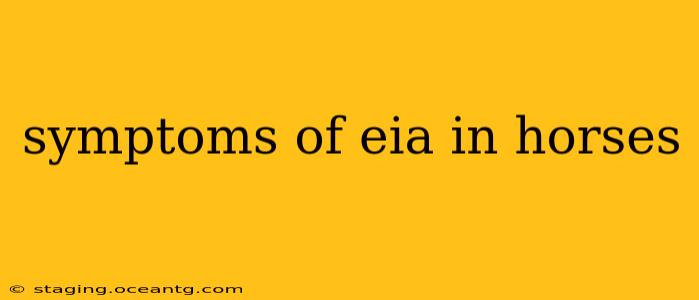Equine Infectious Anemia (EIA), also known as swamp fever, is a serious, incurable viral disease affecting horses and other equids. Early detection is crucial for managing the disease and preventing its spread. However, EIA often presents subtly, making diagnosis challenging. This article will detail the common symptoms of EIA in horses, addressing frequently asked questions to provide a comprehensive understanding.
What are the early signs of EIA in horses?
Early stages of EIA can be insidious, often presenting with non-specific symptoms easily mistaken for other illnesses. These early signs might include:
- Intermittent fever: A fluctuating temperature is often an early indicator. The horse might have periods of normal temperature followed by spikes, making it difficult to diagnose initially.
- Lethargy and weakness: The horse may appear unusually tired, exhibiting reduced energy levels and a reluctance to move.
- Weight loss: Gradual but noticeable weight loss, despite maintaining a normal appetite, can be a significant symptom.
- Depression: A general lack of enthusiasm and a subdued demeanor are common early signs.
- Pale gums or mucous membranes: A subtle but significant sign that can indicate anemia, a key feature of EIA.
It’s important to note that these early symptoms are nonspecific and can be associated with various other equine ailments. This emphasizes the importance of thorough veterinary examination and testing.
How is EIA diagnosed in horses?
A definitive diagnosis of EIA relies on specific blood tests, primarily the Coggins test. This test detects antibodies against the EIA virus. A positive Coggins test confirms the presence of the virus and, thus, the diagnosis of EIA. Other tests may be used to confirm the diagnosis and monitor the disease's progression.
What are the more advanced symptoms of EIA in horses?
As the disease progresses, symptoms become more pronounced and debilitating:
- Severe Anemia: This leads to pale mucous membranes, weakness, and potentially life-threatening complications.
- Recurrent Fever: More frequent and intense fever episodes are common in advanced stages.
- Swollen Lymph Nodes: Enlarged lymph nodes, especially in the neck and jaw area, can be a noticeable symptom.
- Jaundice (Icterus): Yellowing of the skin and whites of the eyes indicates liver involvement.
- Edema: Swelling in the legs, abdomen, and other areas due to fluid retention.
- Neurological Signs: In some cases, advanced EIA can manifest neurological symptoms such as incoordination and weakness.
Can EIA be cured in horses?
Unfortunately, there is no cure for EIA. Treatment focuses on managing symptoms and supporting the horse's overall health. This may involve providing supportive care, managing fever, and addressing secondary infections. Prognosis varies depending on the severity of the disease and the horse's individual response to treatment.
How is EIA transmitted between horses?
EIA is primarily transmitted through blood-to-blood contact. This can occur through:
- Blood-sucking insects: Horseflies and other biting insects are significant vectors for the disease.
- Contaminated needles and syringes: Sharing needles during vaccinations or other procedures can transmit the virus.
- Contaminated equipment: Shared equipment, such as surgical instruments, can spread the virus if not properly sterilized.
- Vertical Transmission (mare to foal): Although less common, the virus can be transmitted from an infected mare to her foal.
What is the prognosis for a horse with EIA?
The prognosis for horses with EIA varies greatly. While the disease is incurable, some horses can live for years with minimal symptoms if managed effectively. However, the disease can cause significant health problems and even death, particularly during acute episodes. Regular veterinary monitoring is crucial to manage the disease and improve the horse's quality of life.
This information is intended for educational purposes only. Always consult with a veterinarian for any concerns regarding your horse's health. Early detection and careful management are key to improving the welfare of horses affected by EIA.
